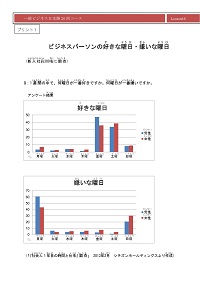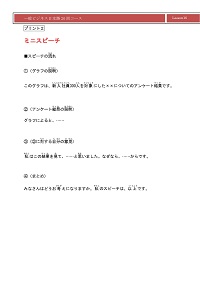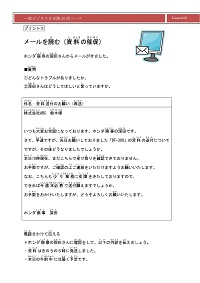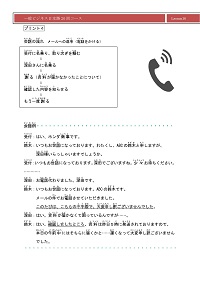About the courses
- Home
- Course List
- General Business Japanese Course (20 Lessons)
General Business Japanese Course (20 Lessons)
- Level of lesson
- Intermediate-Advanced
- (Japanese Language Proficiency Test N2-N1 equivalent)
- Course consists of twenty 50-minute lessons
Provides comprehensive study in the basic etiquette, honorific language, and internal/external communication, which are indispensable in the Japanese business world. Students will learn a good balance between the Japanese etiquette necessary for effective communication, and practical Japanese expressions used in emails and on the phone. In the “Brushing Up on Japanese” sections, students will review and practice pronunciation and grammar, improving their fundamental Japanese skills, while also learning how to logically and concisely express themselves through short speeches.
| Lessons | Topics | Details |
|---|---|---|
| 1 |
Short Speeches: Self-Introductions Conversation (1): Explaining foreign names |
Students think about how to give self-introductions that leave an impression, and explain their name in such a way that people will remember. |
| 2 |
Brushing Up on Japanese Conversation (2): Explaining Japanese names |
Students practice Japanese pronunciation. They also learn how to explain kanji used in names. |
| 3 |
Brushing Up on Japanese Business Etiquette & Communication (1): Exchanging business cards |
Students practice Japanese accents and intonation. They also learn the proper way to exchange business cards. |
| 4 |
Brushing Up on Japanese Business Etiquette & Communication (2): Seating order and business meal etiquette & communication |
Students practice forms of expression related to time and duration. They also learn etiquette in dealing with visitors/clients and business meals, as well as proper seating order and communication styles for various situations. |
| 5 |
Brushing Up on Japanese Conversation (3): Greetings and inoffensive expressions |
Students practice how to use "~んです(-ndesu)," which is often used incorrectly in sentences. They also learn basic inoffensive expressions and often-used greetings. |
| 6 |
Brushing Up on Japanese Business Etiquette & Communication (3): The basics of honorifics |
Students practice words/phrases with similar meanings often used in business situations. They also review the basics of honorific language such as sonkeigo and kenjogo often used in business situations. |
| 7 |
Brushing Up on Japanese Business Etiquette & Communication (4): Ho-Ren-So (report, contact, consult) |
Students practice conjunctive expressions often used in business situations. They also learn about the proper behavior of working adults both in and out of the office. |
| 8 |
Brushing Up on Japanese Business Etiquette & Communication (5): How to back-channel |
Students practice abbreviated words and katakana often used in business situations. They also study a variety of back-channeling expressions and learn how to be good listeners. |
| 9 |
Brushing Up on Japanese Business Etiquette & Communication (6): Basic rules for telephone conversation |
Students practice the intransitive verbs and transitive verbs often used in business situations. They also learn expressions often used when receiving and making calls. |
| 10 |
Short Speeches Conversation (4): Application of honorifics |
Students choose one theme and explain it in detail. They also learn common honorific expressions outside of the scope of basic honorific language. |
| 11 |
Short Speeches Business Etiquette & Communication (7): General communication (internal) |
Students learn how to express their feelings, and use this skill in conversation. They also learn about internal communication in business, using concrete examples. |
| 12 |
Short Speeches Conversation (5): Honorific idioms (internal) |
Students choose one theme and explain it in detail. They also learn honorific idioms often used internally. |
| 13 |
Short Speeches Conversation (6): Business phone calls |
Students choose between two themes and give their opinion on why one theme is better than the other. They also review the basic rules of business phone calls, how to receive calls, and what to do when a call recipient is unavailable (away from their desk or out). |
| 14 |
Short Speeches Business Etiquette & Communication (8): Email (1) |
Students look at pictures and give their opinions on them. They also learn the basic structure of emails, and common expressions used in them. |
| 15 |
Short Speeches Business Etiquette & Communication (9): Taking messages |
Students explain the details of a graph. They also review how to receive phone calls, how to convey messages that are given to them, and how to write down these messages. |
| 16 |
Short Speeches Business Etiquette & Communication (10): Email (2) |
Students look at a graph and give their opinion on it. They also review common expressions used in emails, and practice responding appropriately to an email query. |
| 17 |
Short Speeches Business Etiquette & Communication (11): Etiquette when visiting other companies |
Students look at a graph and give their opinion on it. They also learn etiquette when visiting other companies and how to make appointments. |
| 18 |
Short Speeches Business Etiquette & Communication (12): Business etiquette (external) |
Students learn keywords and use them in conversation. They also discuss external business etiquette, and learn about expressions that may be grammatically correct, but inappropriate. |
| 19 |
Short Speeches Conversation (7): Honorific idioms (external) |
Students learn keywords and use them in conversation. They also learn idioms used externally and for visitors and clients. |
| 20 |
Short Speeches Recap |
Students talk about their goals for the future, engage in a recap role-play, and review what they have learned throughout the course. |
*Lesson content and order may change.
Teaching materials and lesson formats
Each lesson will proceed following a few pages of printed materials. In the first half of the lesson, you will practice more natural pronunciation and expressions as well as speeches in order to clearly articulate your thoughts. In the latter half, you will increase your knowledge of Japanese business manners while practicing conversation through role plays of various business scenes, such as phone calls, in-house communications, and making appointments.








